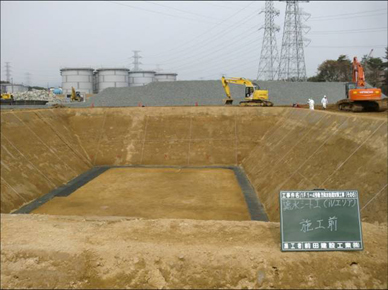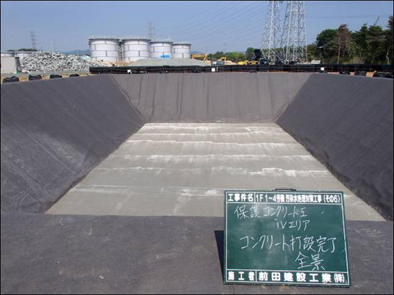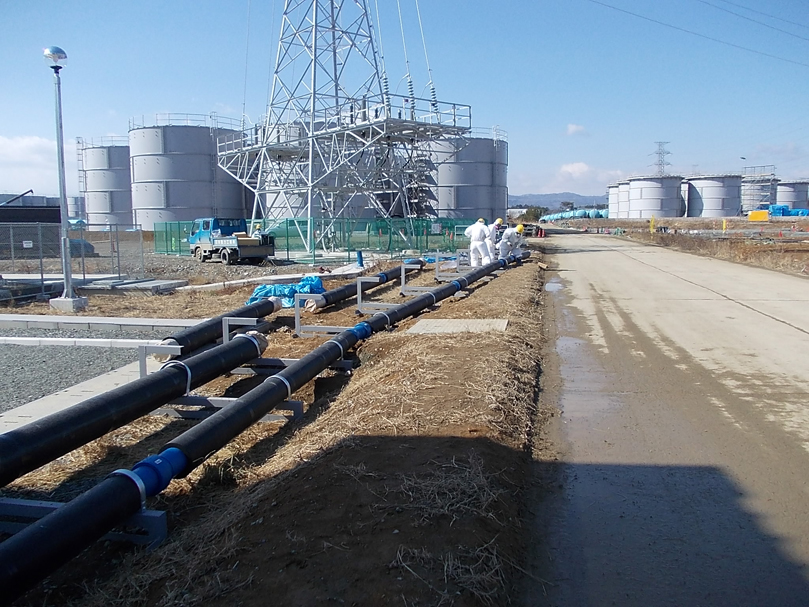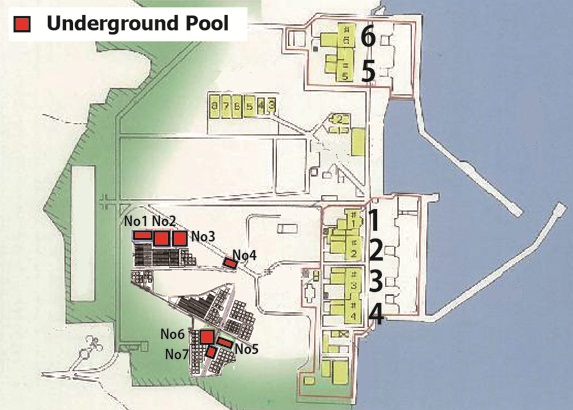Despite the fact that no one knows where or in what condition the melted nuclear fuel from the reactor core is located at present, it is absolutely necessary to continue cooling it. The cooling operation will have to be maintained over a long period of time, until the fuel is fully recovered and removed. As of January 22, 2013, approximately 360 tons of cooling water was being poured daily into the reactor vessels. The cooling water eventually becomes highly radioactive and contaminated, leaks into the reactor building basements, and from there to the turbine building basements. Moreover, roughly 400 tons of groundwater is flowing into the basement of the reactor buildings each day. This is because TEPCO maintains the level of the radioactive water at around three meters above the sea level to reduce the risks of discharging and leaking the contaminated water into the ocean. Since July 2011, the cooling water has been recycled and reused, but the amount of inflowing groundwater is steadily increasing. The contaminated water contains a huge amount of radioactive material and is highly radioactive. For this reason, safe management of the water is extremely difficult. The plant operator removes cesium and salt from the contaminated water before storing it in storage tanks and underground storage pools on the plant’s premises. Contaminated water leaking from underground storage pools
Leaking of the contaminated water was first discovered in the No.2 storage pool. This was made public late at night on April 5. The leaking pool measures 60m in length, 53m in width, and 6m in depth, and was filled with 13,000 tons of contaminated water. Judging from the fact that the water level began declining and radioactivity was detected from the water samples collected from the detection holes, TEPCO appears to have suspected that the water leaks began sometime around March 20. The radioactivity levels of the sampled water continued to surge, while the water level in the pool declined further, forcing TEPCO to disclose the water leaks. When the company brought the leaks to light, it estimated that the leaked contaminated water totaled 120 tons. They calculated this based on the fact that the water level in the pool dropped by 4 cm. TEPCO also estimated the total amount of radioactivity in the leaked water at 710 billion Bq. On April 7, it was discovered that water was also leaking from the No.3 storage pool. TEPCO took the temporary measure of moving the contaminated water from the faulty No.2 storage pool to the No.1 storage pool, but on April 9, it was discovered that water was also leaking from the No.1 storage pool. TEPCO is said to have moved the water quickly to yet another underground pool. Radiation in the contaminated water
The analysis results, however, contain data on only four items, the radionuclides Iodine-131, Cesium-134 and 137, and total beta radioactivity. The maximum dosage registered on April 10 in the sample water from the leakage detection hole on the northeastern side of No.1 storage pool stood at 1,100 ppm of chlorine, below the detection limit of iodine and cesium, and 23,000 Bq/cm3 of total beta radioactivity. Total gamma radioactivity was also included in the results, which stood at 28 Bq/cm3. Nevertheless, the analytical data for the radioactive water in the underground storage pools have yet to be made public, and the contamination levels of the water is unknown. The contaminated water passes through the cesium adsorption filtration system, but other radionuclides are not removed. The water contains Strontium-90 (half-life about 29 years), and other radionuclides, such as plutonium and americium, although the amount of these substances seems to be small. In addition, the water also contains cobalt. There is thus a need to publish the detailed results of the analysis of the contaminated water. Faulty facility The underground storage pools are lined with a three-layer impermeable lining material comprised of two 1.5 mm polyethylene sheets and a 6.4 mm layer of bentonite clay. Non-woven fabric is included between the two sheets. TEPCO explained that since the leak monitoring pipe passes through the lining material covering the top of the pool, the company had previously presumed that the lining had moved slightly due to the weight of the water, creating a space around the pipe, allowing water to seep out. If this analysis were correct, the water leak would continue only for a limited time, until the water level dropped. Moreover, water leaks would not occur there unless the pool was full. The reality is that leaks were discovered when the No.1 storage pool, containing highly radioactive water from other storage pools, was half full. TEPCO’s explanation contradicted this fact and was therefore proved false. As a result, the most likely cause of the water leaks would be a tear in the liner, or a gap created where liner sections are joined. The seven water storage pools were built to the same design. Water leaks from one of them means that other pools may have similar defects. TEPCO was, therefore, forced to conduct checks on the other pools, and on April 19, expressed the view that a crack had emerged in the concrete base under the liner sheets, placing localized pressure on the liner and creating a hole in that location. However, hampered by the high radiation level, the utility is facing great difficulty in substantiating this view. TEPCO on a tightrope devising contaminated water storage plans In a news conference on April 10, TEPCO announced its plan to discontinue the use of the storage pools, and to build more tanks above ground into which the contaminated water from the pools would be transferred. According to the plant operator, the company had constructed the large-capacity underground storage pools because it was difficult to build tanks under transmission lines, and because the existing tanks had already taken up almost all available space at the plant. With the outbreak of the water leaks, TEPCO is being pressed to totally rethink effective countermeasures for dealing with the increasing amount of contaminated water. The utility also announced that it will transfer the 7,100 tons of the contaminated water from the No.1 and No.2 underground storage pools to tanks by the first half of May, and the 16,500 tons from the No.3 and No.6 pools by the first half of June. The company went on to say that the transfer of the contaminated water from the No.4 storage pool to the tanks will be carried out after these transfer operations. This means that the water leaks from the Nos.1, 2, and 3 storage pools will continue until the transfer operations are completed. The combined storage capacity of the existing tanks totaled 267,000 tons as of April 2, of which about 95 %, or 253,000 tons, was already being used. It is therefore impossible to transfer all of the remaining 23,600 tons of water from the storage pools to tanks. In view of this situation, TEPCO plans to build more tanks (with a combined capacity of 126,000 tons) by September, and at the same time, use filtrate tanks (total capacity 22,000 tons) designed for storing purified water for cooling nuclear reactors. Now that approximately 400 tons of groundwater is flowing into the reactor buildings each day, the plant operator appears to be walking a tightrope in dealing with the swelling amounts of contaminated water. Fundamental measures need to be taken TEPCO insists that the pools were built using widely-used water-storage technology. But what consideration was given to the adequacy of the storage pools for highly radioactive water, which are required to be absolutely leak-free? We suspect that the utility introduced the storage pool in haste, taking advantage of their low cost and short construction period, and without making a full feasibility study of the plan. Furthermore, TEPCO seems to have the intention of operating ALPS and discharging the processed water into the ocean after removing the radionuclides. The company is apparently attempting to resolve the storage capacity shortage problem in this way. The operation of ALPS, however, has been delayed substantially due to vulnerabilities of its storage vessel, pointed out by the Nuclear Regulation Authority (NRA). The system is currently undergoing experimental operation. If it works well, ALPS is not capable of removing tritium, a radioactive isotope of hydrogen. Although TEPCO says it will release the processed water into the sea after obtaining consent from the local residents, fishermen are worried about the possible impacts and are strongly opposed to this plan. Under these circumstances, it will not be easy for the utility to win consent from local residents. The fundamental cause of the growing amount of contaminated water at the plant is the groundwater flowing into the reactor buildings. Considering the need to continue cooling of the molten nuclear fuel for decades, TEPCO should promptly take more fundamental measures, such as measures to block the flow of groundwater into the facility. Hideyuki Ban, (Co-Director of CNIC) Return to CNIC's Earthquakes and Nuclear Power page Return to NIT 154 contents |

| CNIC Citizens' Nuclear Information Center Akebonobashi Co-op 2F-B, 8-5 Sumiyoshi-cho, Shinjuku-ku, Tokyo, 162-0065, Japan TEL.03-3357-3800 FAX.03-3357-3801 Map http://cnic.jp/english/ |




